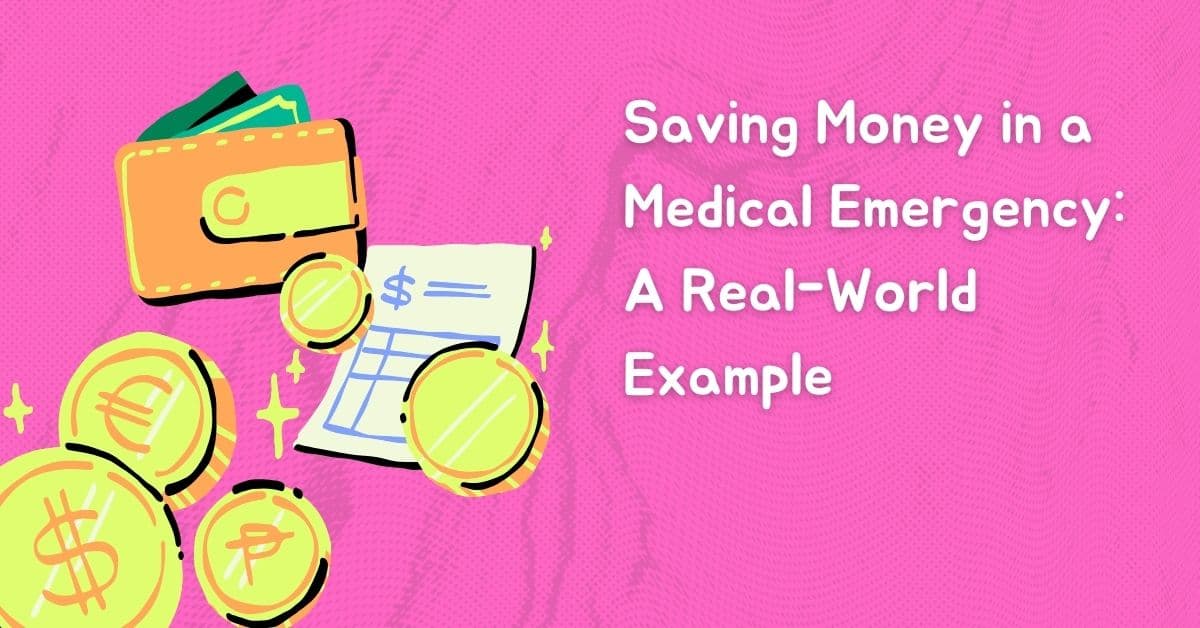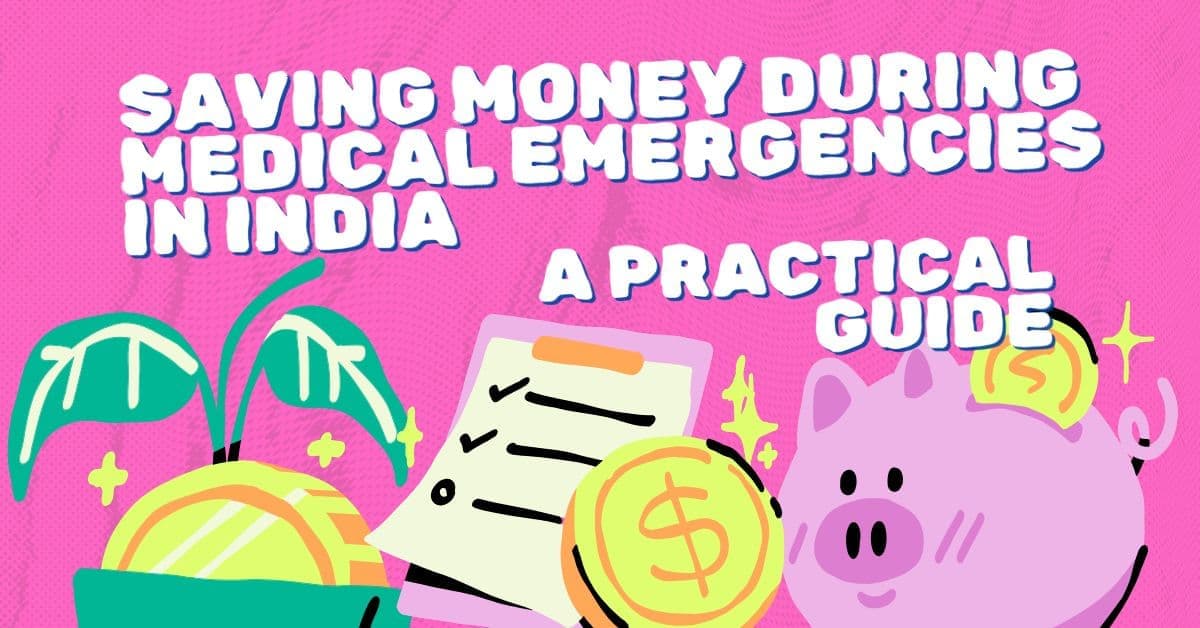Saving Money During Medical Emergencies in India: Unexpected medical crises can leave Indian families feeling both financially and emotionally burdened. Unpreparedness can deplete funds or force households into debt in a nation where healthcare prices are on the rise—private hospital fees for a single treatment can easily surpass ₹50,000. Millions of Indians must deal with the financial burden of medical crises, whether they include an unexpected operation in Delhi, a protracted sickness in Mumbai, or an accident in rural Kerala.
What is the good news? You may save money on medical emergency in India without sacrificing treatment if you prepare ahead and use wise tactics. This thorough book explains how to lower expenses, safeguard your cash, and get ready for unforeseen medical emergencies. To make sure you’re prepared for anything in 2025, we’ll offer helpful, India-specific advice on anything from using government programs to setting up emergency money.
Why Are Medical Emergencies a Financial Challenge in India?
Although there are both public and private healthcare providers in India, the situation is rather different:

- High Out-of-Pocket Costs: According to the National Health Accounts (2023), people bear more than 60% of healthcare costs.
- Increasing Treatment Costs: In private hospitals, a simple operation like an appendectomy can cost between ₹30,000 and ₹1 lakh, while intensive care unit stays can cost up to ₹10,000 per day.
- Limited Insurance Penetration: Many Indians are at risk since just 37% of them have health insurance (IRDAI, 2024).
- Cultural Factors: Especially for elderly parents, family responsibilities sometimes result in excessive care expenditures.
Saving money in India amid medical emergency requires more than simply taking short cuts; it also requires preparation and awareness of your alternatives.
How to Save Money in Medical Emergencies: A Comprehensive Guide
Here’s how to safeguard your finances in the event of a medical emergency:
1. Use Zero-Based Budgeting to Create an Emergency Fund
Your first defence is an emergency fund. Prioritise savings by using zero-based budgeting (ZBB), in which each rupee of income is given a specific purpose.
- How It Operates: Set aside a certain sum (for example, ₹5,000 per month) for a medical emergency fund until it covers three to six months’ worth of costs (₹1-3 lakh for most homes).
- Example: In India, a family with a monthly budget of ₹50,000 would have ₹20,000 for necessities, ₹15,000 for discretionary spending, ₹5,000 for SIP, ₹5,000 for an emergency fund, and ₹5,000 for miscellaneous spending, leaving ₹0 left over.
- Advice: For convenient access, place this investment in a liquid asset such as a liquid mutual fund or savings account.
Why It Saves Money: It pays for upfront expenses (such tests and medications) without requiring loans or credit card debt with interest rates of 36%.
2. Make Use of Government Health Programs
In times of emergency, India has subsidised healthcare choices that can significantly lower costs:
- Ayushman Bharat PM-JAY: Provides secondary and tertiary care at affiliated hospitals to more than 50 crore Indians, up to ₹5 lakh per household each year.
- Eligibility: Determine whether your family is eligible (e.g., rural poor, urban workers) by visiting pmjay.gov.in.
Savings: At a PM-JAY facility, a ₹2 lakh heart operation is now free. - State Schemes: Maharashtra’s MJPJAY and Tamil Nadu’s CMCHIS provide comparable advantages.
- Public Hospitals: District hospitals, AIIMS, and government medical institutes levy little fees (e.g., ₹500 to ₹5,000 for procedures).
The Reason It Saves Money lessens the need for costly private care, particularly for low-income households.
3. Obtain Reasonably Priced Health Insurance
In India, health insurance is revolutionary for reducing costs during medical emergencies:
- Options: Family Floater Plans (e.g., Star Health, HDFC Ergo): ₹10,000–₹20,000 yearly cost for ₹5–10 lakh coverage.
- Plans for critical illnesses: lump sum payments (₹5–10 lakh) for conditions like stroke or cancer.
- Indian Context: The cost of surgery is reduced by ₹1 lakh+ with a ₹10,000 premium.
- Advice: To save money on premiums, get your policy in your 20s or 30s. For full coverage, include your parents.
The Reason It Saves Money limits out-of-pocket costs and, after deductibles, pays 80–100% of expenditures.
4. Bargaining for Medical Bills
Although private hospitals sometimes overcharge, haggling can result in thousands of dollars saved:
- How to Do It: Ask for an itemised bill and raise concerns about pointless testing or exorbitant prescription prices.
- For instance, in Bangalore, a gallbladder operation bill of ₹1.5 lakh was negotiated down to ₹1.2 lakh.
- Advice: If possible, choose package offers (such as ₹50,000 for all-inclusive surgery).
The Reason It Saves Money preserves your emergency fund by reducing discretionary costs by 10–30%.
5. Make use of generic medications and tests
Costs are increased by private labs and branded medications, although there are alternatives:
- Purchase generic medications from Jan Aushadhi Kendras (paracetamol costs ₹2 instead of ₹20 for Crocin, for example).
- Diagnostics: Test prices are 50–70% lower at government laboratories or subsidised chains like SRL Diagnostics.
- Indian Example: Using generics reduces a ₹5,000 prescription drug expense to ₹1,500.
The Reason It Saves Money lowers ongoing expenses for chronic crises like diabetes or the healing process following surgery.
6. Use Crowdfunding and Community Support
In times of crisis, community assistance is crucial in India:

- Friends and family: Take out interest-free loans rather than expensive personal loans.
- Crowdfunding: Websites such as Ketto or Milaap assist in raising money for significant crises, such as a transplant that costs ₹10 lakh.
- Indian Example: To pay for a child’s leukaemia treatment, a family in Chennai gathered ₹5 lakh using Milaap.
The Reason It Saves Money avoids financial pitfalls by supplementing your money.
7. Select a Hospital From a strategic standpoint
Costs are affected by where you get treatment:
- Urban vs. Rural: Compared to metro areas, Tier-2 cities (like Coimbatore) provide high-quality healthcare at 20–40% reduced costs.
- Trust Hospitals: Charitable facilities with lower costs include Aravind Eye Hospital and Tata Memorial (cancer).
- Example: In India, cataract surgery at Aravind costs ₹20,000, whereas private clinics charge ₹50,000.
The Reason It Saves Money strikes a balance between cost and quality, particularly for scheduled crises.
Saving Money in a Medical Emergency: A Real-World Example
Introducing Prem, a 35-year-old Hyderabad-based IT specialist who makes ₹80,000 a month. In 2025, his father had a heart attack that necessitated a ₹2.5 lakh angioplasty at a private hospital. This is how Prem was able to save money:

- Emergency Fund: ₹1 lakh paid for the first expenses (admission, testing).
- Insurance: After a ₹30,000 deductible, a ₹5 lakh family floater policy paid ₹1.2 lakh.
- Negotiation: By challenging add-ons, the amount was lowered by ₹20,000.
- Generic medications: cost ₹5,000, while branded medications cost ₹15,000.
- Out-of-pocket total: ₹55,000, which is 78% less than the initial ₹2.5 lakh.
Prem maintained his financial stability through cost-cutting, insurance, and investment management.
Advantages of Being Ready to Save Money in Medical Emergencies
- Peace of Mind: Being prepared financially eases tension in times of emergency.
- Debt Avoidance: Avoid debt by avoiding loans with interest rates between 12 and 36 percent.
- Improved Access to Care: Savings guarantee prompt, hassle-free care.
- Long-Term Security: Preserves other objectives (e.g., retirement, education).
Problems and Fixes
- Problem: No previous saves.
Solution: Start small by using ZBB to save ₹1,000 per month till you reach ₹50,000. - Problem: Delays in filing insurance claims.
Solution: Opt for cashless coverage and prepare your paperwork (prescriptions, invoices). - Problem: Access to projects in rural areas is a challenge.
Solution: Take patients to district hospitals via telemedicine (e.g., eSanjeevani).
Apps and Tools for Indians:
- Policybazaar (insurance comparison), Practo (finding inexpensive hospitals).
- Government portals include janaushadhi.gov.in (generic drug retailers) and pmjay.gov.in (Ayushman Bharat eligibility).
- Budgeting: To keep track of emergency funds, use Moneycontrol or Google Sheets.
Why It’s Important to Save Money in India During Medical Emergencies
Medical crises can jeopardise not just one’s health but also one’s financial independence. Families may have to sell possessions or lose years’ worth of savings with a single ₹1 lakh charge. You may protect your future by saving money for medical emergencies in India, whether you want to purchase a house, pay for your child’s education, or live well in retirement. Being prepared is empowering in a nation where healthcare is not completely subsidised.
Money-Saving Strategies for Medical Emergencies
- Get Started Early: In your 20s and 30s, start saving money and getting insurance.
- Teach the family: Inform your spouse or parents about programs like PM-JAY.
- Review Every Year: Inflation-adjust savings (e.g., 5% increase in 2025).
- Keep Up to Date: Keep up with changes to healthcare policy (e.g., Budget 2025).
- Little Victories: Celebrate when you save ₹10,000 on a bill; it gives you more self-assurance.
Conclusion: Plan Ahead and Save Wisely
It takes planning and awareness to save money in India amid medical crises. You may survive medical emergencies without going bankrupt by setting up an emergency fund, using insurance, taking use of government programs, and making economical decisions. Start now by obtaining a ₹5 lakh policy, setting away ₹2,000 per month, or investigating your eligibility for PM-JAY. These precautions guarantee that you’re prepared for anything, safeguarding your wealth and well-being in a country where every rupee matters.
Money in Control: Best Apps to Track Your Expenses
Financial Planning Tips for Income from Household Property
Smart Saving Strategies for Indian Middle Class Families
How to Save Money for Black Friday Deals in India
